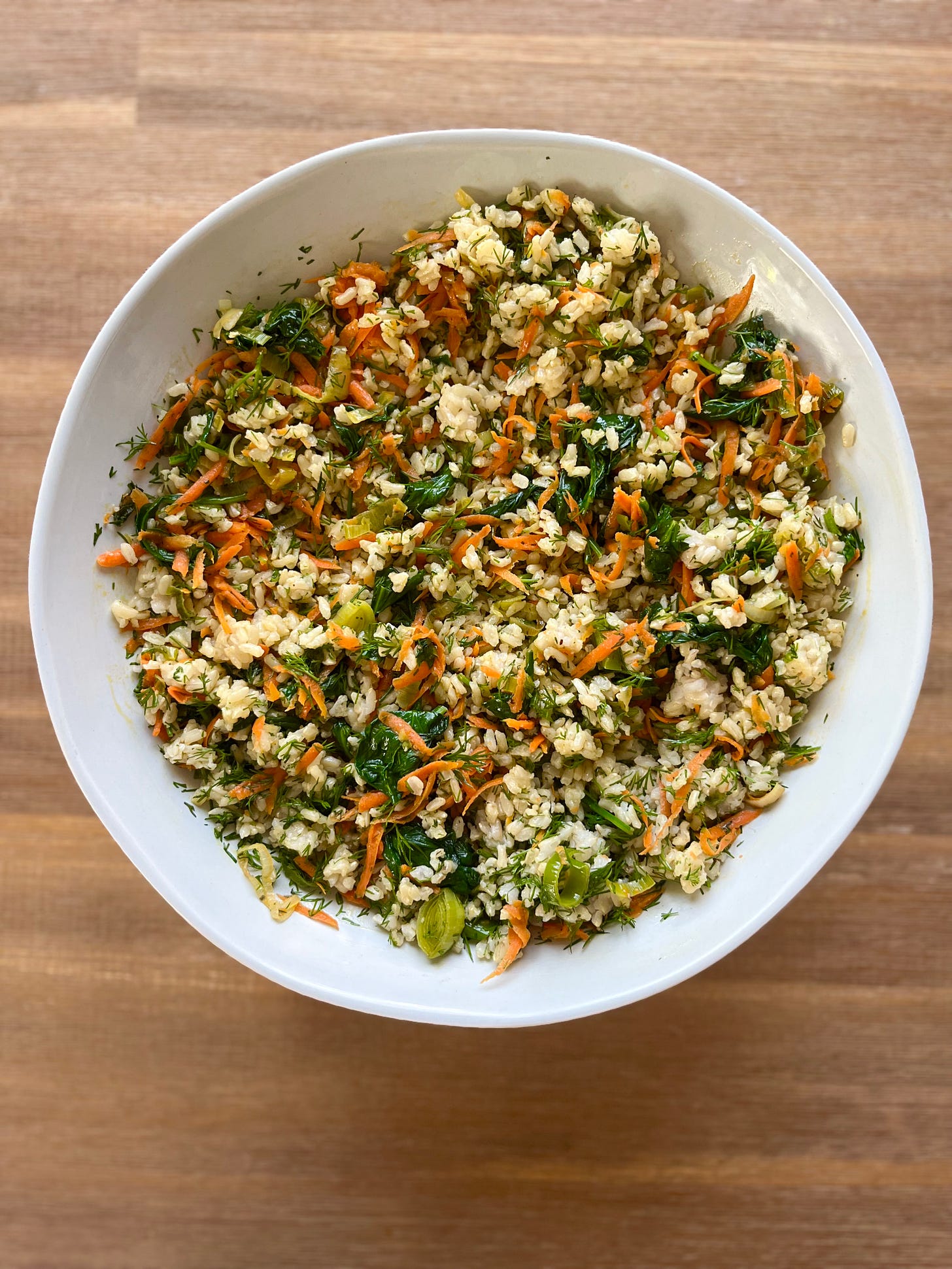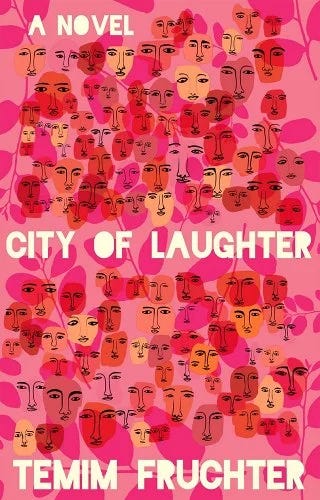

Discover more from The Jewish Table
Just before the New Year, The Jewish Table crossed the threshold of 500 paid subscribers (and 8,000 total subscribers)! In celebration of this milestone, I’m making this week’s newsletter—which would normally just be sent to paid subscribers—open to all. Next week, I’ll go back to the usual schedule of weekly newsletters for paid subscribers and monthly-ish newsletters for free subscribers. If you don’t want to miss out on the fun and recipes, and/or you want to start the year off supporting Jewish food writing, upgrade to a paid subscription today. Thank you!
Raise your hand if you read cookbooks like novels and collect them like precious objects. [Imagine me emphatically raising my hand.] Well, a few weeks ago, my good friend Anna Hanau (hi Anna!) sent me a text that she was helping to clean out the home of an elderly neighbor who had passed away. And did I maybe want to take a peek at some of the Jewish cookbooks on their shelf?
Yes. Yes, I absolutely did. Anna sent me a few iPhone snaps, and I ended up requesting about a dozen and a half cookbooks I didn’t already have—a mix of synagogue sisterhood collections and classics like the 2nd Ave Deli Cookbook. The problem is Anna lives in Rochester, and I live in Brooklyn.
So in a feat of logistical genius, Anna passed two cardboard boxes full of books along to her mother-in-law, Rachel. Rachel schlepped them from Rochester (where she lives) to Brooklyn (where she had a work meeting). She dropped them off at my kids’ school in a different part of Brooklyn, leaving them with the security guard. From there, I picked them up (yes, along with the kids) and brought them home.
The whole thing made me miss Anna terribly. But it also brought me great joy because I now have *so many new Jewish cookbooks* to read through. The books’ previous owner clearly loved them and used them frequently, judging by the number of post-its and scraps of paper bookmarking different pages. They are not in great aesthetic shape, and could have easily been tossed in the trash. But thanks to Anna’s thoughtfulness—and my insanity for choosing to add more cookbooks to my already over-crowded shelf—they were given a second life. Here’s a sampling of the haul:
One of my favorites of the bunch is From My Grandmother’s Kitchen: A Sephardic Cookbook, written in 1984 by Viviane Alchech Miner. It represents a number of similar cookbooks published in the latter half of the 20th century where people—often, but not always women—noticed that their family’s or community’s historical Jewish dishes were dying out, and so collected those recipes and wrote cookbooks about them as a way of cultural preservation. Claudia Roden’s iconic The Book of Jewish Food represents this same phenomenon, though on a much broader and more scholarly scale.
I love how Viviane delves into the history of her family, the Benaroyas, in From My Grandmother’s Kitchen. She includes many photos and anecdotes of her Turkish/Greek Sephardic family that settled in Geneva, Switzerland. (Her own family moved to America in the 1950s.) Readers learn that Viviane’s grandfather would often entertain the family by singing folk songs in Judezmo (also called Ladino)—a Judeo-Spanish language that is the Sephardi equivalent to Yiddish. “One song warned Jews to pack their belongings and flee Spain as soon as their names appeared on a list in the town center,” she writes. “As he sang, we felt the apprehension our ancestors must have felt during the Inquisition many centuries ago.”
What inspires me less, unfortunately, are the book’s recipes. They are interesting from a historical perspective, to be sure—dishes like rice fritters made with grated kaseri cheese and dill, Turkish fried noodles with tomato sauce, and chicken with fava beans. But like many historical/family recipe books, they fall a little flat in the flavor department. Tastes have changed overtime, of course, as has access to a global pantry of ingredients. So it makes sense that a recipe for beet salad that calls for just beets, onion, oil, and lemon juice, would feel by today’s standards as if it was missing something.
My original plan for this week’s recipe was to pull a dish directly from the pages of From My Grandmother’s Kitchen and share it with you. (Longtime readers of this newsletter will remember my semi-regular “Adventures in Cooking My Cookbook Collection” column, which I’d hoped to revive this week.) Unfortunately, none of the recipes spoke to me as written.
So instead, I took my cue from the cookbook’s most prominently used flavors and ingredients, particularly rice, spinach, leeks, and dill. And the resulting dish, a pilaf-ish medley I’m calling Dilled Rice with Carrots, Leeks, and Spinach, is really lovely. The mix of nutty rice with earthy spinach, sweet carrots, and bright leeks and dill is simple to prepare—weeknight-friendly for sure, but also special enough to serve to company. It is bursting with fresh, herbal flavor, while still feeling appropriately seasonal. And it makes a fantastic antidote to January’s gray and dreary vibes.
With apologies to Viviane for taking some culinary liberties with her family’s recipes, I hope this dish inspires you to enjoy the flavors of her grandmother’s kitchen at your table.
What are you cooking this January? Let us know in the comments below.
Dilled Rice with Carrots, Leeks, and Spinach
This simple side dish is perfect as is. But if you are the kind of cook who likes to riff on recipes (aka my kinda cook), you can add some toasted nuts (like almonds or pine nuts), stir in some cheese (like crumbled feta or grated parmesan), or fold in cooked beans (like white beans or chickpeas). Serve it straight up, or make it yours.
Serves 6
1/4 cup (60 ml) extra-virgin olive oil, plus more for drizzling
2 small leeks (white and light green parts), cleaned well and thinly sliced
5 ounces (140 g) baby spinach
2 medium carrots, peeled and grated on the large holes of a box grater
3/4 teaspoon kosher salt, plus more as needed
Freshly ground black pepper
5 to 6 cups cooked brown or white long-grained rice, warm (see rice notes below*)
1 cup (40 g) finely chopped fresh dill
Heat the olive oil in a large frying pan set over medium heat. Add the leeks and cook, stirring often, until softened and golden, 10-15 minutes. Stir in the spinach and grated carrots and cook, stirring often, until the spinach wilts and the carrots soften slightly, about 2 minutes. Stir in the salt and a generous amount of black pepper. Remove from heat and let cool slightly.
Place the desired amount of cooked rice in a large serving bowl and drizzle with a little olive oil. Add the slightly cooled veggie mixture and the chopped dill, and toss to combine. Taste and add more salt or pepper, as needed. Serve warm or at room temperature.
*Rice Notes:
You can use any long grain brown or white rice you like that yields relatively separate, non-sticky/mushy grains. Brown or white basmati are particularly good fits.
3 cups of dried rice grains yields about 6 cups cooked. You can use all of the cooked rice if prefer your side dish to be a little more rice heavy. Use slightly less of the cooked rice (reserve the remainder for another meal) if you prefer the dish to be more vegetable and herb heavy. For reference, I used 5 cups of cooked rice in the photo above.
I usually cook my rice while sautéing the veggies so everything is ready to go at the same general time. But you can also use day-old cooked rice in this recipe. Here’s how to revive/plump up day-old rice.
Bonus Reading: City of Laughter
My sister-in-law, Temim Fruchter’s debut novel, City of Laughter, comes out later this month, and it’s so great! I’m only partway through, but have absolutely fallen in love with the gorgeously mysterious story, not to mention Temim’s storytelling. (She also wrote this beautiful essay in the NY Times yesterday, as if I need more reasons to shep nachas.)
Pre-order City of Laughter now in hardcopy or audiobook. (Mara Wilson, of Matilda and Mrs. Doubtfire fame, narrates the audiobook!) And here’s a little more info about City of Laughter from Temim’s publisher, Grove Atlantic:
An ambitious, delirious novel that tangles with queerness, spirituality, and generational silence, City of Laughter announces Temim Fruchter as a fresh and assured new literary voice. The tale of a young queer woman stuck in a thicket of generational secrets, the novel follows her back to her family's origins, where ancestral clues begin to reveal a lineage both haunted and shaped by desire.
Ropshitz, Poland, was once known as the City of Laughter. As this story opens, an 18th century badchan, a holy jester whose job is to make wedding guests laugh, receives a visitation from a mysterious stranger--bringing the laughter the people of Ropshitz desperately need, and triggering a sequence of events that will reverberate across the coming century. In the present day, Shiva Margolin, recovering from the heartbreak of her first big queer love and grieving the death of her beloved father, struggles to connect with her guarded mother, who spends most of her time at the local funeral home. A student of Jewish folklore, Shiva seizes an opportunity to visit Poland, hoping her family's mysteries will make more sense if she walks in the footsteps of her great-grandmother Mira, about whom no one speaks. What she finds will make her question not only her past and her future, but also her present.
Electric and sharply intimate, City of Laughter zigzags between our universe and a tapestry of real and invented Jewish folklore, asking how far we can travel from the stories that have raised us without leaving them behind.
Subscribe to The Jewish Table
recipes + stories from the world of jewish food, by leah koenig








Thanks for this great recipe Leah! My husband was excited to see ‘’fancy’’ rice for dinner. I appreciate that this recipe can be made with brown rice (child of the 70s and I just don’t like the lack of taste in white rice). I substituted what I had-mustard greens and parsley-but I can’t wait to make this with the dill and spinach.
I too, am a cookbook lover. I just read through Adeena Sussman's latest and love it. I put at least 30 bookmarks in and will be making each recipe until I go on to Shannon Sarna's . I have my Oma's cookbooks, and my Mom's. I have at least 100 that I use often enough to see usage, including Julia Childs.
I love your recipe, Leah, made it to have tomorrow for late lunch. I am baking some Baguettes in the morning to go with it.